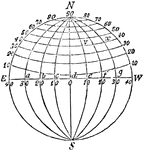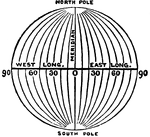Clipart tagged: ‘Longitude’

Longitude
"Let this figure represent the Earth, N being the north pole, S the south pole, and E W the equator.…

Meridians and Parallels
The Meridian of any given place is that half of the meridian circle which passes through that place…

Meridians of Longitude
Meridians of longitude are the imaginary vertical lines that run around the Earth. These lines divide…